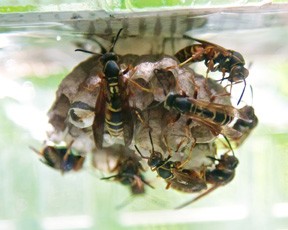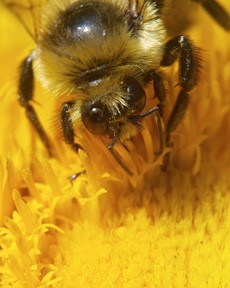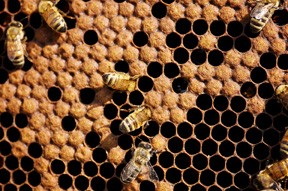Stinging Days of Summer
- Share
- Tweet
- Pin
- Share
It’s been a tough summer for Robert Puccini, at least where insects are concerned. A sting in July during football camp left his right hand swollen like a balloon, and the next month a sting in the knee put him in the hospital.

Robert Puccini’s swollen hand.
“It was just frightening because we didn’t know what was going on,” said Renee Puccini, Robert’s mother. “He’s only 14, he shouldn’t be having chest pains.”
Robert’s doctor said that he’s seen a lot of patients for stings this year and has gotten plenty of practice admitting patients with allergic reactions.
“This summer has just been terrible, from what we heard from the doctor,” Renee said.
Mike Flood, a nurse practitioner at Aurora Health Center, agrees. He said he saw more patients for bee stings in the last two weeks of August than he ever has before – and he’s been practicing in Door County for over 30 years. Lately he’s been up to four stung patients a day.
“The four I see is probably only five percent of what actually happens,” Flood said.

Wasps making a hive. Photo by Len Villano.
But according to Phillip Pellitteri, an entomologist with UW – Madison Extension, this year hasn’t been too bad for stings in Wisconsin. Hot years are typically the worst, but even considering this summer’s scorching temperatures he didn’t get as many complaints about stings as he has in past years.
“It’s definitely not a bring-tears-to-my-eyes sort of thing for wasp problems,” Pellitteri said.
Although Wisconsin hasn’t seen an abundance of wasps this year, Pellitteri said a new stinging insect recently moved into the state – the German yellowjacket. Toward the end of the summer, these wasps start to run out of food to feed their young and start scavenging for sugar and protein. So food, especially sugary food, attracts them.
“This has dramatically kicked up the number of stings in outdoor restaurants during the day, farmers markets,” Pellitteri said. “Anyplace there’s a reliable food source they come in.”

A bee collects nectar and pollen from a flower. Photo by Len Villano.
Local outdoor restaurants have battled with bees. The Cookery in Fish Creek has traps filled with dish soap and Mello Yello to attract bees and keep them away from outdoor diners. The traps work well, but there have still been days where servers couldn’t seat customers outside because of the bees.
“As soon as the food is set down the bees seem to go straight for it,” said Karin Skare, Cookery employee. “Especially breakfast – the bees seem to like jam and sweet things.”
And stings from yellowjackets are especially unpleasant, compared to honey bees or bumble bees. Yellowjackets’ stingers don’t have a barb, so they can sting over and over.
“Yellowjacket [stings] hurt more, generally swell more, and generally even after the swelling goes down people complain about it itching for a few weeks afterwards,” Pellitteri said.
Incidents with wasps like German yellowjackets doesn’t always happen around food. They nest in the ground, and when they’re disturbed by footprints or a lawnmower, they get temperamental and likely to sting. Underground nests are often hard to see until it’s too late.

Honey bees work in the hive. Photo by Len Villano.
Flood suggests people without bee allergies treat stings at home. People can put vinegar, baking soda or toothpaste on a sting neutralizes the venom, and take an antihistamine, medicine that prevents the itching and swelling associated with allergies. He said patients like Robert that are allergic to bee stings should see an allergist and carry an EpiPen, a device used to inject medicine that prevents severe allergic reaction.
So now as he heads into football season, Robert will have to take extra precaution against stings.
“Everywhere we go now we’re going to have to take an EpiPen,” Renee said. “We just don’t know what’s going to happen.”
